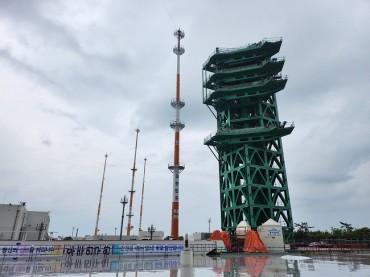
“The treatment device circulates the patient’s bed and shoots photon beams from multiple angles,” said a radiation oncology professor at Samsung Hospital. “And its precise targeting capability has almost no effect on other normal tissue. As such, it is the perfect technology for pediatric cancer patients, who need to avoid radiation exposure.” (image: KobizMedia/ Korea Bizwire)
SEOUL, May 24 (Korea Bizwire) – Photon and baryon therapies have been referred to as ‘dream cancer treatment’. Major Korean hospitals are implementing the therapies in their cancer treatment programs, bringing up hopes for domestic cancer patients.
According to industry representatives, Samsung Hospital started its first photon treatments this month, and Severance Hospital recently decided to implement baryon therapy by 2020.
The fundamentals of both treatments are the same. Photon and baryon therapies are types of radiation treatment that target cancer cells with precision by accelerating hydrogen and carbon particles, respectively.
Photon therapy accelerates the protons within a hydrogen atom’s nucleus to 60 percent of light speed to destroy cancer cells. On the other hand, baryon therapy, which has not been implemented yet in Korea, aims to kill cancer cells by speeding up the baryons of carbon and other heavier elements to near-light speed.
Both treatments take advantage of the Bragg peak, and precisely attack cancer cells without affecting other normally-functioning cells. The Bragg peak is a phenomenon in which the beam penetrates all normal tissues until it reaches the cancer, at which point the energy level peaks to its maximum and rapidly dissipates.
Hence, the treatments have a clear advantage over existing radiation therapies, which often induce negative health affects throughout the body.
Also, the latest advancement in photon therapy – like the one currently being used at Samsung Hospital – allows better precision in aiming the photon beam, further enhancing its pinpoint targeting of cancer cells.
“The treatment device circulates the patient’s bed and shoots photon beams from multiple angles,” said a radiation oncology professor at Samsung Hospital. “And its precise targeting capability has almost no effect on other normal tissue. As such, it is the perfect technology for pediatric cancer patients, who need to avoid radiation exposure.”
On the other hand, baryon therapy is known to be three times more destructive when it comes to killing cancer cells. As the therapy uses much heavier elements such as carbon, the energy released also becomes greater when striking the malicious cells.
“You can think of it as either striking with a ping-pong ball, or a golf ball,” said a radiation oncology professor at Severance Hospital. “Because of its more destructive capacity, it can shorten the duration of treatment and can also be more effective with incurable cancers.”
The burden of high prices for photon treatment lessened with the recent health insurance policy set by the Ministry of Health and Welfare, which extended national insurance coverage to all pediatric cancers and numerous adult cancers, such as brain tumors, and esophagus and pancreatic cancer. Until September 2015, photon therapy was covered only for brain tumors and head and neck cancer patients under 18 years of age.
The new policy reduced the price of photon therapy, which used to range from 10 million to 20 million won, to between 5 and 6 million won. Baryon therapy is also expected to be covered by national insurance as long as the procedure takes place in Korea.
By Lina Jang (linajang@koreabizwire.com)






